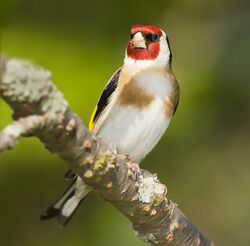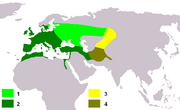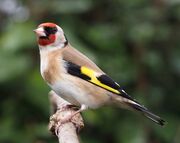Biology:Carduelis
| Carduelis | |
|---|---|

| |
| The European goldfinch belongs to a group of red- or yellow-faced species | |
| Scientific classification | |
| Domain: | Eukaryota |
| Kingdom: | Animalia |
| Phylum: | Chordata |
| Class: | Aves |
| Order: | Passeriformes |
| Family: | Fringillidae |
| Subfamily: | Carduelinae |
| Genus: | Carduelis Brisson, 1760 |
| Type species | |
| Fringilla carduelis[1] Linnaeus, 1758
| |
| Species | |
|
3, see text | |
The genus Carduelis[2] is a group of birds in the finch family Fringillidae.
The genus Carduelis was introduced by the French zoologist Mathurin Jacques Brisson in 1760 by tautonomy based on Carl Linnaeus's specific epithet for the European goldfinch Fringilla carduelis.[3][4] The name carduelis is the Latin word for the European goldfinch.[5]
The polyphyletic nature of the genus was confirmed by Dario Zuccon and coworkers in a comprehensive study of the finch family published in 2012. The authors suggested splitting the genus into several monophyletic clades, a proposal that was accepted by the International Ornithologists' Union.[6] The siskins and goldfinches from the Americas formed a distinct clade and were moved to the resurrected genus Spinus, the greenfinches were moved to the genus Chloris, the twite and linnets formed another clade and were moved to the genus Linaria and finally the redpolls were moved to the genus Acanthis.[7]
Species
The genus Carduelis is now restricted to three European species:[7]
| Common name | Scientific name and subspecies | Range | Size and ecology | IUCN status and estimated population |
|---|---|---|---|---|
| European goldfinch | Carduelis carduelis (Linnaeus, 1758) Fourteen subspecies
|
Europe, North Africa and western Asia.
|
Size: Habitat: Diet: |
LC
|
| Citril finch | Carduelis citrinella (Pallas, 1764) |
Europe from Spain to the Alps | Size: Habitat: Diet: |
LC
|
| Corsican finch | Carduelis corsicana (Koenig, 1899) |
Corsica and on the Italian islands of Sardinia, Elba, Capraia and Gorgona | Size: Habitat: Diet: |
LC
|
References
- ↑ "Fringillidae". The Trust for Avian Systematics. https://www.aviansystematics.org/4th-edition-checklist?viewfamilies=196.
- ↑ From Latin carduus, "thistle". Thistle seeds are a favorite food of many species.
- ↑ Paynter, Raymond A. Jnr., ed (1968). Check-list of birds of the world, Volume 14. Cambridge, Massachusetts: Museum of Comparative Zoology. p. 234. https://www.biodiversitylibrary.org/page/14481435.
- ↑ Brisson, Mathurin Jacques (in Latin, French). Ornithologie. Paris. Volume 1 p. 36; Volume 3 p. 53.
- ↑ Jobling, James A. (2010). The Helm Dictionary of Scientific Bird Names. London, United Kingdom: Christopher Helm. p. 91. ISBN 978-1-4081-2501-4. https://archive.org/details/Helm_Dictionary_of_Scientific_Bird_Names_by_James_A._Jobling.
- ↑ Zuccon, Dario; Prŷs-Jones, Robert; Rasmussen, Pamela C.; Ericson, Per G.P. (2012). "The phylogenetic relationships and generic limits of finches (Fringillidae)". Molecular Phylogenetics and Evolution 62 (2): 581–596. doi:10.1016/j.ympev.2011.10.002. PMID 22023825. http://www.nrm.se/download/18.9ff3752132fdaeccb6800010935/Zuccon%20et%20al%202012.pdf.
- ↑ Jump up to: 7.0 7.1 Gill, Frank; Donsker, David, eds. "Finches, euphonias". World Bird List Version 5.2. International Ornithologists' Union. http://www.worldbirdnames.org/bow/finches/.
External links
- Carduelis videos, photos and sounds on the Internet Bird Collection
Wikidata ☰ Q27757 entry
 |




